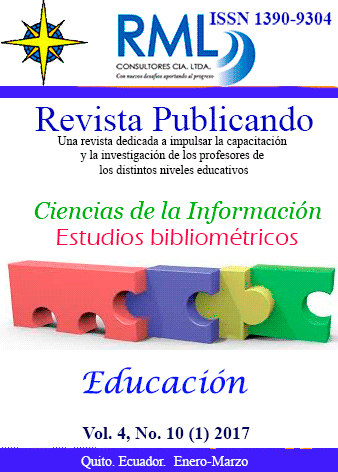Abstract
El turismo es una actividad que genera desarrollo local y puede mejorar la calidad de vida de una población a través del empleo. Los paisajes naturales inspiran bajo una perspectiva individual a admirar el sentido del lugar, de la historia, el espíritu y la gente ( Marcos Recio, 2005), lo que invita de manera silenciosa y con fortaleza visual a conocer lugares de distintas partes. El objetivo de este artículo es medir el atractivo de los paisajes naturales turísticos de la Provincia de Tungurahua, usando Google Maps, para observar el impacto de las fotografías esféricas y tratar de determinar el valor que un usuario da a un paisaje. Se procedió a la elaboración de fotos esféricas, de paisajes de los diferentes cantones de la Provincia de Tungurahua, las fotografías fueron publicadas en Google Maps con la finalidad de mostrar los paisajes turísticos que ofrece la provincia y estos inspiren ir a conocer el lugar de forma presencial. La socialización de las fotografías para turistas se realizó mediante redes sociales y eventos de presentación del trabajo realizado.
En el transcurso de un año las visitas registradas a las fotografías esféricas de los paisajes turísticos, según el contador de visitas de Google Maps, llegaron a 992.283 de un total de 339 paisajes publicados, lo que nos señala que los paisajes si tuvieron acogida con posibles turistas, y a la vez se abre puertas a futuros trabajos con la interrogante ¿las fotografías publicadas en Google Maps atrajeron turistas al lugar?References
Aires Barroso, G., & Nicolau Mota, K. C. (2010). Marketing turístico internacional. La Marca Brasil. Estudios y perspectivas en turismo, 241-267.
Hidalgo-Alcázar, C., Sicilia, M., & Ruiz De Maya, S. (2015). La Imagen de un Producto Turístico Rural a través del Acceso al Contenido Generado por otros Usuarios en Internet: Diferencias por Género. Journal of technology management & innovation, 75-84.
Marcos Recio, J. C. (2005). http://web.a.ebscohost.com. Obtenido de http://web.a.ebscohost.com/ehost/pdfviewer/pdfviewer?sid=6417f682-6e09-4b4e-bc94-04895faf6137%40sessionmgr4004&vid=1&hid=4114
Vila Subirós, J., Varga Linde, D., Llausí s Pascual, A., & Ribas Palom, A. (2006). Conceptos y métodos fundamentales en ecología. Unitat de Geografia i Institut de Medi Ambient, 151-166.
concept360. (23 de 04 de 2017). concept360. Tour Virtual. . Obtenido de http://www.concept360.es/
de Vries, S., Buijs, A., Langers, F., Farjon, H., & Hinsberg, A. (2013). Measuring the attractiveness of Dutch landscapes: Identifying national hotspots of highly valued places using Google Maps. Applied Geography, 220-229.
De Vries, S., Lankhorst, J.-K., & Buijs, A. (2007). Mapping the attractiveness of the Dutch countryside: A GIS-based landscape appreciation model. Forest Snow and Landscape Research, 43-58.
Giriwati, N., & Homma , R. (2013). Urban tourism: Designing a tourism space in a city context for social sustainability. 8th International Conference on Urban Regeneration and Sustainability. Malaysia.
Google. (23 de 04 de 2017). Google Maps. Obtenido de https://www.google.com.ec/maps/@-1.2591361,-78.6398736,15z
Honorable Gobierno Provincial de Tungurahua. (15 de Abril de 2017). Honorable Gobierno Provincial de Tungurahua. Obtenido de Honorable Gobierno Provincial de Tungurahua: http://www.tungurahua.gob.ec/
Kim, S., Junuzovic, S., & Inkpen, K. (2014). The Nomad and the Couch Potato: Enriching Mobile Shared Experiences with Contextual Information. Proceedings of the 18th International Conference on Supporting Group Work, (págs. 167-177). Nueva York, USA.
Medaglia Silveira, J., & Eduardo Silveira, C. (2009). La evolución del marketing de destinos. Estudios y perspectivas en turismo, 530-545.
Pan , B., MacLaurin , T., & Crotts, J. (2007). Travel Blogs and the Implications for Destination Marketing. Journal of Travel Research, 45.
Rakić , T., & Chambers, D. (2011). An Introduction to Visual Research Methods in Tourism. UK: Routledge.
Rosales, A. (2009). Fotografía Esférica. En A. Rosales, Fotografía Esférica (pág. 38). Valencia: Universidad Politecnica de Valencia, Servicio de Publicación.
Schmallegger, D., & Carson, D. (2008). Journal of Vacation Marketing. Obtenido de Blogs in tourism: Changing approaches to information exchange: http://dx.doi.org/10.1177/13567667070875
Vargas Jiménez, D., & Otero, J. (2015). Desarrollo e Implementación de Recorridos 360 º en portales Joomla! Redalyc.org, 61-69.
You are free to:
Share — copy and redistribute the material in any medium or format.
Adapt — remix, transform, and build upon the material.
The licensor cannot revoke these freedoms as long as you follow the license terms.
Under the following terms:
Attribution — You must give appropriate credit, provide a link to the license, and indicate if changes were made. You may do so in any reasonable manner, but not in any way that suggests the licensor endorses you or your use.
NonCommercial — You may not use the material for commercial purposes.
ShareAlike — If you remix, transform, or build upon the material, you must distribute your contributions under the same license as the original.
No additional restrictions — You may not apply legal terms or technological measures that legally restrict others from doing anything the license permits.
